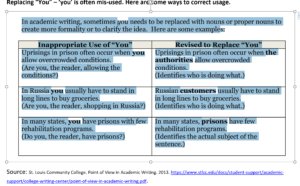The final essay due date is Mon. June 13. I cannot accept any later submissions. These essays take time to mark.
The final essay requires:
- Introductory paragraph (see below for ‘how to’)
- Body paragraphs, each with topic and concluding sentences CHY4U_CCA_Essay_Topic_and_Concluding_Sentences
- Connection to thesis/HTC paragraphs (if they are separate – otherwise part of body paragraphs)
- Concluding paragraph (see below for ‘how to’)
- Footnotes for ALL evidence Footnote_Format_2020
- Bibliography at the end (does not count in page count) Bibliography-and-Topic-Sentences_2020
- Max 12 pages double-spaced (minimum 10 point font, normal margins)
- Title page (does not count in page count)
Title page:
- Your name
- Title of your essay (not the topic)
- Date: _____________
- School: York Mills CI
- Teacher: Ms. Gluskin
- Course: CHY4U
Process
when Ms. G was working on turning her essay outline into a draft she did the following things IN THIS ORDER:
- first made all changes/improvements in the outline (including turning citations into proper Chicago style footnotes – a bit of a lengthy process) – for PSD evidence: CHY4U_CCA_Integrating_Quotations_into_Sentences
- then converted tables to text
- made separate paragraphs for connections to thesis/HTC (because body paragraphs were getting too long in some cases, not all)
- divided large sub-topics into smaller body paragraphs
- wrote basic topic and concluding sentences for all body paragraphs
- added intro paragraph (leave this until the end since you already have your thesis)
- added concluding paragraph
- added bibliography
- made title page
* Special note – make sure each paragraph has a connection to thesis! If your paragraphs are too big, you can have HTC/Connection to Thesis Paragraphs (but they still need TSs and CSs)
Samples (and process from previous years):
CHY4U_MsG_Essay_Draft5__Final_Nov_2020
Last year
I am still calling it outline draft 4 but you will see that I have gotten rid of the rows and columns and have proper footnotes. The bibliography is incomplete and a lot of formatting still needs to be done. But now I have an idea that my essay is too long because the page limit is 12! So a lot of editing will be required.
CHY4U_MsG_Essay_Outline_Draft4_2020
Now I have tidied up my footnotes and bibliography (though there is still a footnote issue I need to deal with and I have to add the rest of my sources from my notes to the bib). I have added some concluding sentences (still need a few more). I have decided where I am going to break up large paragraphs into smaller ones (though I haven’t done it yet – note – when you break a large paragraph up you have to remember to that each paragraph needs a TS and a CS).
CHY4U_MsG_Essay_Draft2_2020 (June 4)
Now I’m working on breaking up my large sub-topics into smaller paragraphs, making sure all paragraphs have a topic and concluding sentence. The introductory and concluding paragraphs are done, too.
CHY4U_MsG_Essay_Draft3_2020 (June 5)
My second last draft (I hope): I cleaned up the newly created paragraphs and made sure they all have TSs and CSs. I bolded some more HTC terms throughout the essay. I eliminated my last example as it caused my essay to be over the maximum page limit. I think I’ll do one more clean up draft and that’ll be it.
CHY4U_MsG_Essay_Draft4_2020 (June 10)
I have now finished my final essay. I went through my paragraphs again and made sure everything flowed. I noticed that a few paragraphs were missing connections to thesis! I fixed that. Please makes sure to add page numbers and a title page. Remember, the page limit for the essay itself is 12! Do not go past that.
CHY4U_MsG_Essay_Draft5__Final_2020
2019
Ms. G__Step5_Essay_Draft_1_2019 (May 18 – I converted tables to text, added footnotes, noted where to add TSs and CSs, noted that some paragraphs might need splitting, noted where to add Intro and Conclusion, added bibliography.)
Ms. G__Step6_Essay_Draft_2_2019 (May 20 – I added most of the TSs and CSs. I separated some of the HTCs into new paragraphs. I finished the intro. I finished most of the conclusion. I still have to fix up some of the footnotes and finish off the conclusion. I need to make sure the transitions are effective).
Ms.-G__Step6_Essay_Draft_3_2019 (June 4 – I finished splitting large paragraphs. Added more transitions. I still need to finish the conclusion and get rid of all the headings.)
2018
MsG_Sample_CHY4U_Essay_Draft1_2017-18 (Dec. 20 – I converted my tables to text, added footnotes, noted where to add TSs and CSs, split up some paragraphs, noted where to add Intro and Conclusion)
MsG_Sample_CHY4U_Essay_Draft2_2017-18 (Dec. 30 and Jan. 1 – I added in all TSs and CSs, blocked out my intro and conclusion, divided large sub-topics, added in some transitions. I still need to add bibliography and fix up my footnotes).
MsG_Sample_CHY4U_Essay_Draft3_2017-18 (Jan. 9 – Mostly finished – added bibliography but still need to edit its format; still need to fix up some footnotes, Finished intro and conclusion. )
MsG_Sample_CHY4U_Essay_Draft4_2017-18 (Jan. 12 – Mostly finished – added title page – make sure yours doesn’t have a number on it)
MsG_CHY4U_Essay_Draft1_May22_2016 (last year)
- I inserted comments to highlight for you the process I took to turn my outline into a draft
- If you wrote your outline on the template, make sure you convert it from table to text
Essay Rubric:
– take a good look to see where your marks will come from
Editing and proofreading:
editing involves revising the structure (changing the order of examples, sub-dividing sub-topics into body paragraphs, changing the order of sub-topics, making sure connections to thesis are in the correct place, making sure all body paragraphs have TSs and CSs, making sure all evidence is cited [footnoted])
proofreading involves checking spelling, grammar and style (third person academic)
Academic style:
Academic style:
- Write your essay in third person without using “you”, “we”, or “I.”
- Use formal language – no short forms such as etc., e.g., % (per cent)
- Write out numbers below 10 (one to nine)
- Do not engage in a conversational style – a formal essay requires language that is carefully constructed to teach/educate/prove/persuade

Transitions:
- Create flow in your essay by using transition words to help guide the reader
- That does not mean that every body paragraph should use the same words over and over, such as “for example” or “next.” Not every single example needs a transition word.
- where transition words are most useful is between the different examples inside a sub-topic or paragraph
- because the structure is point, example, point, example (etc.) it can be hard for the reader to see where a new point begins.
- this is the best place to create flow between your examples
- otherwise they can seem choppy
Transition Words – Samples
to give an example: for example, to illustrate, such as, for instance
to add more information: in addition, moreover, furthermore
to show contrast: by contrast, although, even so, however
to conclude: to conclude, overall, as has been noted, (NOT to summarize)
Self and Peer Evaluation:
CHY4U_CCA_Essay_SelfPeer_Eval_2020-21 (this is mainly for structure). You are welcome to exchange with another student.
Editing Assistance:
Last-Minute-Essay-Writing-Tips
Documentation_for_history_essays_REVISED
Structure Tips – Intro and Conclusion:
Think of yourself (the writer) as a tour guide at Casa Loma or another notable site in Toronto.
In the tour analogy, the introductory paragraph would be akin to when tourists are first welcomed into the foyer of Casa Loma. They are welcomed with an interesting little fact or quote about the site (hook), then they are told what they will see on the tour (summary of sub-topics) and then they might be given an overall theme such as Casa Loma reflects a lot of technological advances of its time. Your job is to make the introduction flow. You don’t want it to be choppy or listy. It will flow from most general (hook) to most specific (thesis).
Intro – 3 components:
- hook
- summary of sub-topics
- thesis statement
Nothing more, nothing less.
Concluding Paragraph – 3 components:
- re-state thesis (in different words)
- re-summarize sub-topics (in different words)
- end with a lesson learned or what we call food for thought in English essays (something new – not something already said in the essay – also not a simple cliché such as ‘history really teaches us a lot of lessons)
In the tour guide analogy, this is the wrap up of the tour, back in the foyer. The tour guide reminds the tourists of the main theme of the tour, the rooms they saw on the tour and then leaves them with a final thought. Again, it should flow, not be list-y or choppy. The final thought should not be a repeat of the thesis.
Body Paragraphs – they should be no longer than one page and half. Otherwise they just get too long and the reader can easily get lost. If you need to break up a large sub-topic, don’t forget to add another topic sentence and end each paragraph with its own concluding sentence.
In the tour guide analogy, each body paragraph is like a room on the tour. Of course before the tourists go into each room they are given an introduction to it (topic sentence). Before they leave the room, the tour guide wraps up the importance of this particular room (concluding sentence) .
Arguments – Connections to Thesis (recommended to be separate paragraphs):
these can be improved by keeping a few things in mind:
- don’t merely re-state or summarize what you already said in the evidence
- directly and thoroughly explain how the evidence supports the thesis
- be deep, not superficial
- draw conclusions
- use the guideposts of each HTC and bold them (throughout the essay)
- Cause/consequence
- long, medium, short term
- direct, indirect
- individual, group, social force
- multiple factors working together
- intended/unintended consequences
- Continuity
- progress/decline
- overlap of continuity and change
- plain old repetition of a pattern
- turning point
- Cause/consequence
- explain HTCS – don’t just mention them
_____________________________________________________
When Handing Final Essay In: (June 13)
Title page:
- Your name
- Title of your essay (not the topic)
- Date: _____________
- School: York Mills CI
- Teacher: Ms. Gluskin
- Course: CHY4U
Double-spaced (max 12 pages)
Pages numbered
Bibliography can be page 13
Rubric Attached (see Google Classroom – please make sure to submit it so I can make comments on it)

Yay!